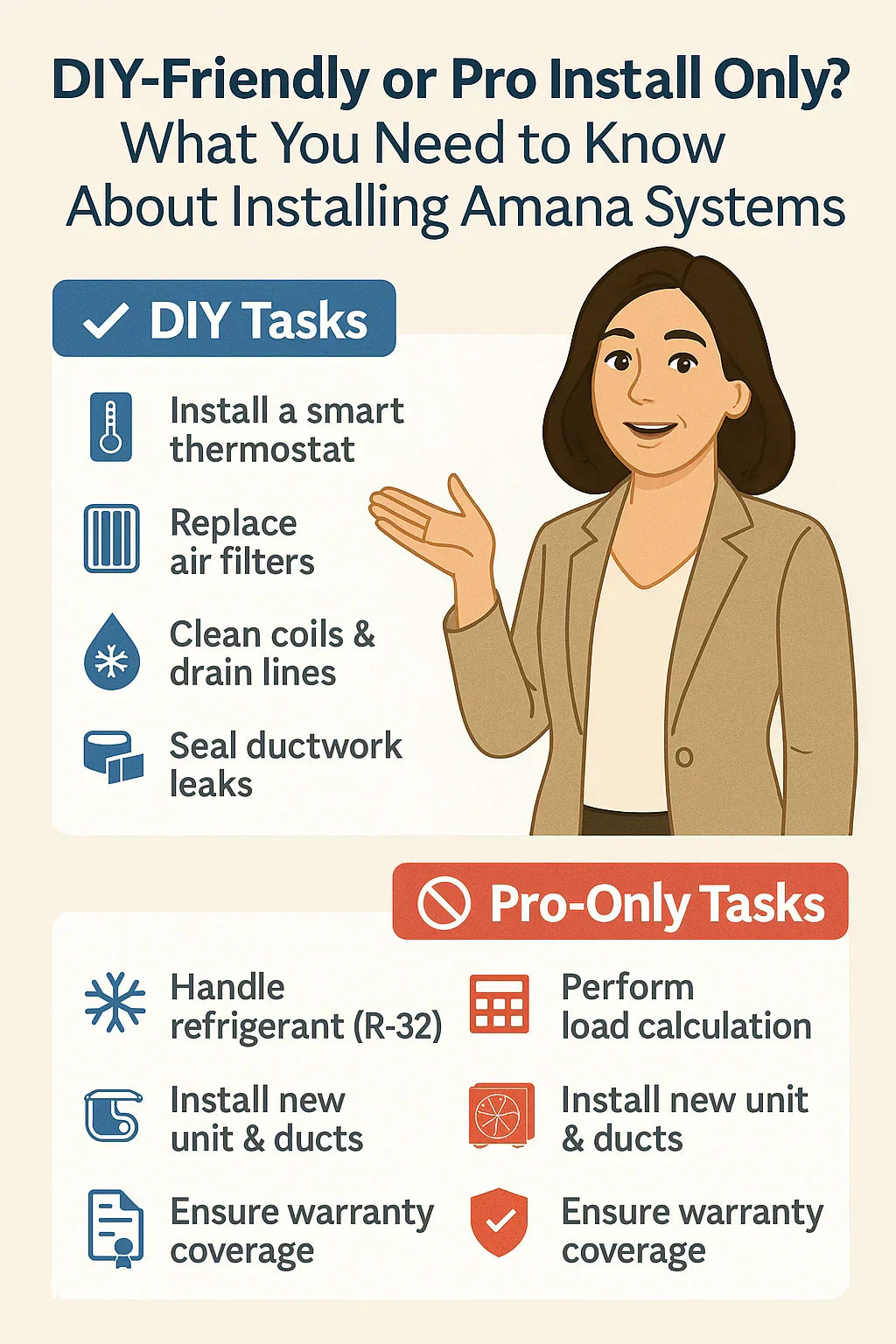Why Installation Matters More Than Ever in 2025
With the new SEER2 efficiency standards and the widespread use of R-32 refrigerant, today’s HVAC systems are more advanced—and more complex—than ever. A sloppy install can lead to:
-
⚠️ Efficiency loss (higher bills, shorter lifespan)
-
⚠️ Safety hazards (fire, leaks, electrical shock)
-
⚠️ Voided warranties (no coverage for expensive repairs)
👉 Consumer Reports notes that installation quality can impact efficiency by up to 30%. That’s why Savvy wanted the full picture.
🏷️ 1. What Makes Amana HVAC Systems Special
Amana is a trusted name in HVAC, but its systems are designed with precision in mind. Here’s what sets them apart:
-
High Efficiency: Many models meet or exceed ENERGY STAR ratings, with SEER2 up to 21.
-
Smart Tech: Compatible with Wi-Fi thermostats and zoning controls.
-
R-32 Refrigerant: More eco-friendly but requires EPA-certified handling.
-
Lifetime Limited Warranty: On compressors and heat exchangers—if professionally installed.
🧰 2. What DIYers Can Safely Handle
Savvy discovered that while full installation isn’t realistic, there are still plenty of DIY-friendly tasks to keep costs down.
✅ Maintenance Tasks You Can Do Yourself
-
Replace Air Filters (every 1–3 months)
-
Clean Indoor & Outdoor Coils (gentle rinsing)
-
Check & Clear Condensate Drain Lines
-
Install a Smart Thermostat (low-voltage wiring, often plug-and-play)
-
Seal Air Duct Joints with UL-approved duct mastic
👉 Energy.gov HVAC Maintenance Tips
❌ Tasks to Avoid DIY
-
Handling refrigerant
-
Installing new line sets
-
Wiring into your breaker panel
-
Furnace gas line hookups
-
Configuring inverter-driven systems
🛠️ 3. Why Most Amana Installs Require a Licensed Pro
Even with Savvy’s can-do spirit, here’s why she decided to call a professional:
⚡ Refrigerant Handling Is Pro-Only
-
Amana’s use of R-32 refrigerant requires EPA Section 608 certification.
👉 EPA Refrigerant Handling Requirements
📏 Correct Sizing via Manual J
-
Contractors use Manual J load calculations to match system tonnage to your home.
-
DIY guesswork risks oversizing (humidity problems) or undersizing (poor comfort).
🛑 Warranty Protection
-
Amana’s Lifetime Limited Warranty is void if not installed by a licensed contractor.
-
Registration within 60 days is required for full coverage.
💲 4. Cost Comparison: DIY vs. Pro
Savvy wanted numbers. Here’s what she found:
| Install Type | Upfront Labor Cost | Risks | Warranty Coverage | Long-Term Value |
|---|---|---|---|---|
| DIY Attempt | $0–$500 (tools) | High (safety + efficiency loss) | None | Poor |
| Pro Install | $2,000–$5,000 | Low | Full coverage | Excellent |
👉 HVAC.com Installation Cost Guide
🏦 5. Rebates & Tax Credits Require Pro Installs
Here’s the deal: no pro install, no rebate.
-
Federal Tax Credits (IRA 2025):
-
Heat Pumps: Up to $2,000
-
High-Efficiency AC: $600
-
High-Efficiency Furnace: $600
-
-
Utility Rebates: Often $500–$1,500 for ENERGY STAR systems
But all require licensed contractor paperwork and AHRI certificate numbers.
👉 IRS – Energy Efficient Home Improvement Credit
📉 6. Common DIY Mistakes Savvy Learned About
-
❌ Incorrect Refrigerant Charge → Burns out compressor.
-
❌ Improper Line Set Length → Leaks and efficiency loss.
-
❌ Wrong Tonnage Selection → Either too hot/cold or wasted money.
-
❌ Poor Duct Sealing → Up to 30% air leakage (Energy.gov)
-
❌ Skipping Permits → Code violations, fines, and lost insurance claims.
💡 7. Savvy’s Smart Installation Strategy
Instead of risking a failed DIY, here’s what Savvy did:
-
✅ Shopped around for 3+ quotes to get fair pricing.
-
✅ Scheduled her install in spring when demand was low.
-
✅ Asked contractors for proof of EPA Section 608 certification.
-
✅ Handled her own thermostat and filter maintenance to save money long-term.
-
✅ Registered her Amana system within 60 days for the Lifetime Warranty.
🧮 8. Real-World Case Study
Savvy’s neighbor tried a DIY heat pump install in 2024:
-
Saved $3,000 upfront.
-
Miscalculated refrigerant charge → compressor failed in 14 months.
-
Warranty denied (non-licensed install).
-
Out-of-pocket repair: $2,700.
Meanwhile, Savvy hired a licensed pro:
-
Paid $4,200 for installation.
-
Qualified for $2,000 federal credit + $900 utility rebate.
-
Net install cost: $1,300.
-
Full warranty coverage → peace of mind.
🎯 Conclusion: Savvy’s Final Word
While I love a good DIY project, installing an Amana HVAC system in 2025 is firmly a Pro Install Only job. Between EPA refrigerant laws, rebate paperwork, and warranty protection, it’s simply not worth the risk.
That said, there’s plenty I still do myself—like filters, thermostats, and seasonal cleaning—to keep costs down. So here’s my advice:
👉 Hire a licensed pro for installation, but take charge of your maintenance. That way, you save money, stay safe, and keep your Amana system running strong for decades.
In the next topic we will know more about: How Efficient Are Amana HVAC Systems? Understanding SEER2, EER & HSPF2 Ratings







